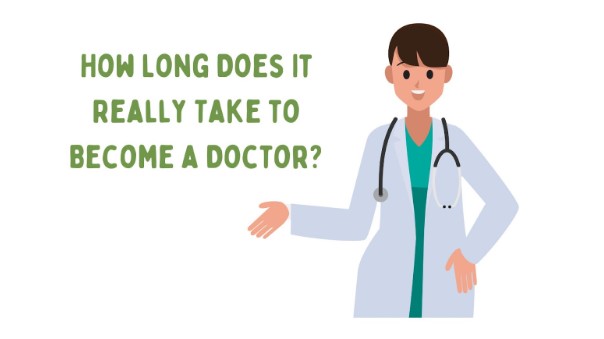
In the U.S., the journey to becoming a doctor takes a minimum of 11 years! And that’s if you don’t go for a specialized field. Think about it—by the time you’re ready to start practicing, you’ve likely spent more than a decade buried in textbooks, labs, and residencies. The path isn’t for the faint-hearted, but if you’re passionate about helping people, it’s totally worth the time and effort.
So, let’s get into it. What does it really take to become a doctor in different parts of the world? We’ll take a look at eight major countries to give you a sense of just how varied the road to “Dr.” can be, depending on where you are. Spoiler alert: the timelines are longer than you’d expect!
So, How Many Years Does It Take to Become a Doctor?
There’s no shortcut here, folks. Becoming a doctor is a long journey everywhere you go. It’s like an academic marathon, with a bunch of stages that feel endless. But here’s the gist:
- High school—Not every country considers this a “pre-med” stage, but it’s still part of the early days.
- Undergraduate study—In some places, you need a bachelor’s degree before med school. Other places? Skip this and go straight in.
- Medical school—This is the heart of it, where you actually start to learn the doctor stuff.
- Residency—This is on-the-job training, where you practice under supervision (and probably don’t get much sleep).
- Specialty training or fellowship—For those going deep into a specific field.
Now, let’s look at how these steps vary across countries. Get ready, it’s a long road ahead.
USA: The Classic 11+ Year Journey to MD

Alright, let’s start with the United States, where the road to becoming a doctor is serious business. Americans love a good structure, and this path is no exception.
The Step-by-Step Pathway
- High School – 4 years of high school, just like everyone else.
- Bachelor’s Degree – Another 4 years. Any major will do, but lots of pre-med hopefuls choose biology or chemistry.
- Medical School – Finally, the good stuff. Four intense years of med school, leading to an MD (Doctor of Medicine).
- Residency – You’re not quite a “real” doctor yet! Residency can last 3 to 7 years, depending on your specialty.
Total Years to Becoming a Doctor: 11+ years
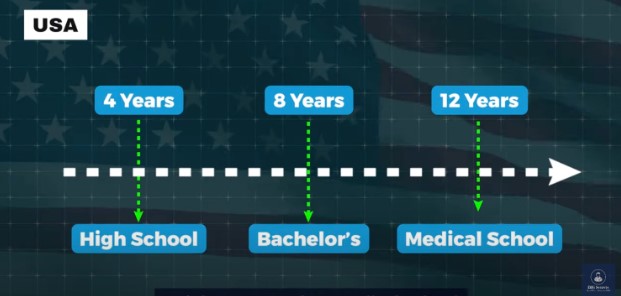
Yep, 11 years is the minimum. But if you want to specialize in the US? You could be looking at closer to 15 years. It’s a long haul, but the payoff is big in terms of knowledge and skill. And, of course, there’s a reason the U.S. healthcare system is known for its rigorous standards.
Canada: Similar to the U.S. Path, With a Few Canadian Twists

Canada’s system is pretty similar to the U.S., with just a couple of unique spins that make it…well, Canadian.
The Roadmap to an MD in Canada
- Bachelor’s Degree – A 4-year degree is the typical start, with a strong focus on science.
- Medical School – Another 4 years of med school to get that MD.
- Residency – This varies by specialty. It can range from 2 years for general practice to 7 years for more specialized fields.
Total Years to Becoming a Doctor: 11+ years
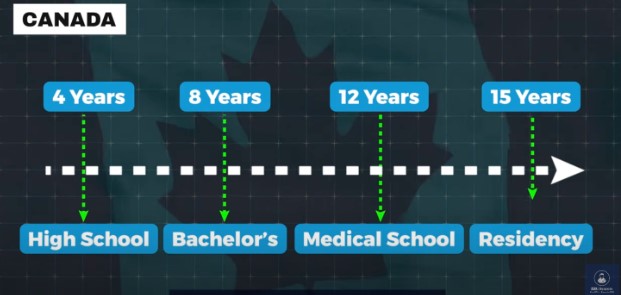
So, about 11 years, give or take. And yes, like in the U.S., Canada’s med school grads often do a fellowship, especially if they want to enter research or focus on something highly specialized. It’s intense, but the Canadian system is designed to build well-rounded doctors, ready to tackle anything thrown their way.
UK: Start Med School Right After High School

In the UK, the process skips the whole “bachelor’s degree first” thing. You can start medical school right after high school, which is a dream come true for those who know they want to be doctors from a young age.
The UK Pathway to Becoming a Doctor
- Medical School – 5 to 6 years, leading to either an MBBS or MBChB degree. This is where the action starts.
- Foundation Training – Two years of general training in hospitals or clinics. Kind of like a broad residency.
- Specialty Training – Now comes the deep dive: 3-8 years of training in the field of your choice.
Total Years to Becoming a Doctor: Around 10+ years
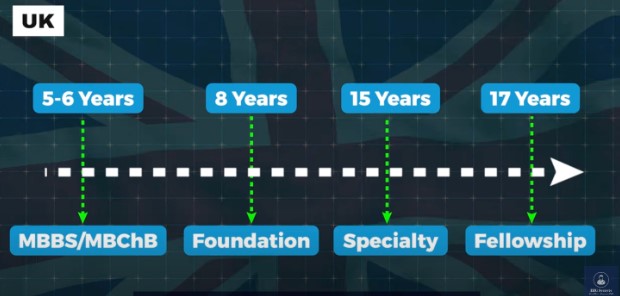
So, while UK doctors can start early, the full training still takes about 10 years. And don’t forget optional fellowships, which can add even more time. British doctors are respected worldwide for their expertise, so while the journey is a bit shorter than in North America, it’s no less thorough.
Australia: Two Paths to Take You to the Finish Line

Australia is all about options, which is fantastic for med students who like to choose their own adventure. There are two main paths, which can speed things up or slow things down.
The Two Training Options in Australia
- Direct Entry Path – Right after high school, straight into medical school for 5-6 years.
- Graduate Entry Path – If you’ve already got a bachelor’s degree, it’s a 4-year MD program.
- Residency – Either way, residency is in your future. This typically lasts about 3 to 7 years.
Total Years to Becoming a Doctor: 7-9 years for direct entry, 11+ for graduate entry
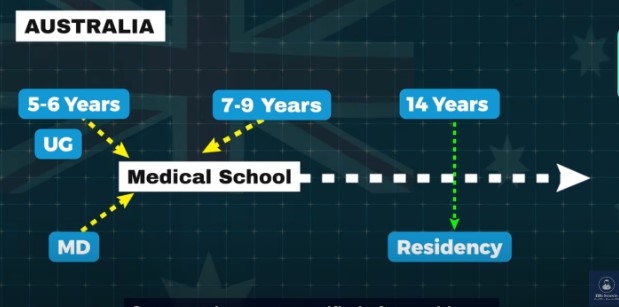
Choosing the direct path can get you in the field faster, but the graduate path gives you a bit more of a foundation. Many Aussie doctors go on to pursue additional fellowships if they want to specialize, adding a few more years to the timeline. The Australian system’s flexibility is a big plus, especially for students looking for faster routes into practice.
India: MBBS, Internship, and Three Years of Specialization

In India, the approach is straightforward. Students enter medical school directly after high school and get a crash course in everything they need to know.
The Road to MBBS in India
- Medical School (MBBS) – 4.5 years of classroom and lab learning. This degree is required to practice general medicine.
- Internship – A mandatory 1-year internship in hospitals and clinics to build hands-on skills.
- Postgraduate Training – Residency for 3 years, depending on specialty choice. Here’s where they gain in-depth expertise.
Total Years to Becoming a Doctor: 8.5+ years
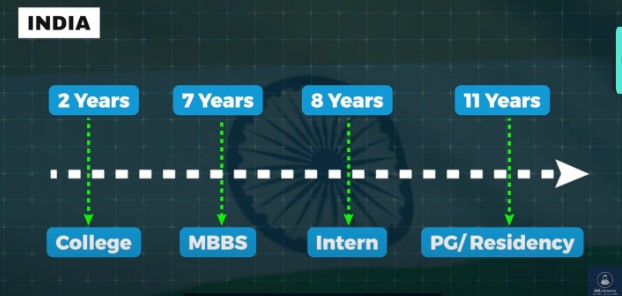
So, about 8.5 years in total, which is shorter than in many other countries. India’s system pushes students to dive in early, meaning they get lots of hands-on experience from the start. After residency, those who want to pursue specialties in fields like surgery can add another few years.
Germany: A Six-Year Medical School and a Long Residency

Germany’s medical training is all about the long game. There’s no rush here; students take their time getting into the finer details of medicine.
Germany’s Medical Path
- Medical School – 6 years to get that MD degree.
- Residency – This can be anywhere from 4 to 6 years, depending on the specialty you choose.
Total Years to Becoming a Doctor: Around 10+ years
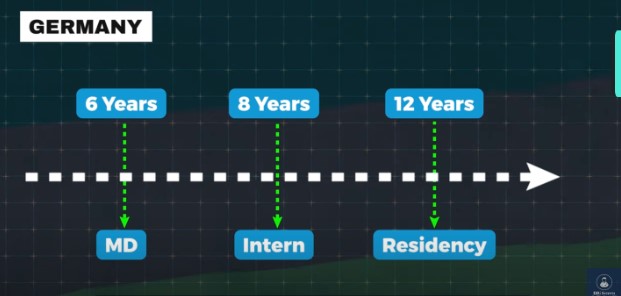
Six years of med school? Yep, that’s the norm in Germany. Then add another 4-6 years of residency, and you’re looking at 10 or more years. It’s a significant investment, but Germany’s training is respected worldwide. Many German-trained doctors are known for their technical skills, particularly in specialized fields like surgery and internal medicine.
Brazil: Six Years of Med School and a Flexible Residency

Brazil’s system produces lots of internationally recognized doctors, many of whom practice in the U.S. and Canada. The path is intense, but adaptable.
Pathway to Medicine in Brazil
- Medical School – Six years in med school, where students tackle both theory and practice.
- Residency – 2-6 years, depending on specialization.
Total Years to Becoming a Doctor: At least 8 years
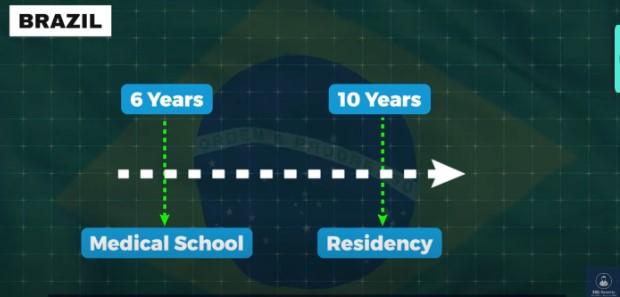
Brazilian doctors jump into medical school right after high school, and after six years, they’re off to residency. With flexibility in residency, Brazilian physicians can take anywhere from two to six years to complete their training. The system’s adaptability helps create doctors who can meet a wide range of demands, which is why they’re so valued in international medical communities.
Japan: A Long Medical School and Structured Residency

Japan’s training system is as organized and thorough as you’d expect. Every year, students add another layer to their medical knowledge.
Japan’s Medical Pathway
- Medical School – Six years, straight from high school to MD.
- Residency – A two-year general residency for clinical experience.
- Specialty Training – Three to six more years, depending on your specialty.
Total Years to Becoming a Doctor: 11+ years
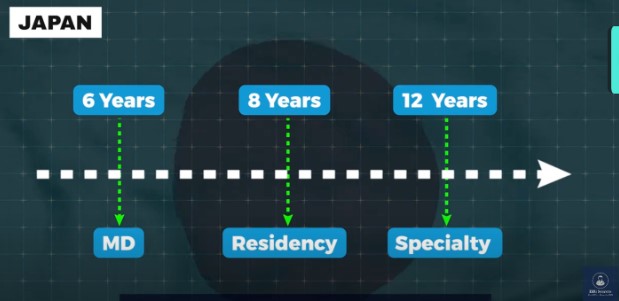
It’s a long road. With six years in med school, followed by a two-year residency, Japanese doctors spend plenty of time preparing. Specialty training can add another three to six years, making for highly skilled professionals who are more than ready by the time they start treating patients on their own.
Key Takeaways: Why Medical Training Takes So Long
If you’re serious about becoming a doctor, know this: the process is long for a reason. Here are the biggest factors that stretch out the timeline:
- Undergraduate Requirements – In places like the U.S. and Canada, med students need a bachelor’s degree before even starting med school.
- Medical School Duration – From four to six years, depending on the country.
- Residency – Another two to seven years, depending on what you want to specialize in.
- Specialty Training – Extra years are often needed for highly specialized fields.

Conclusion
Being a doctor is no quick job. It’s a grind, filled with long hours, loads of study, and an intense commitment to learning. And while the timelines vary from country to country, the end result is the same: highly trained doctors, ready to make a difference in people’s lives.
If you’re thinking about medicine, take a look at the different paths, figure out what works for you, and know that while the journey may be long, the payoff is big.
Dreaming of a career as an International Medical Graduate (IMG) doctor? Visit IMG Secrets to unlock insider tips designed to make your path clearer and your goals closer. Connect with an IMG Secrets Expert Doctor for the support you need to confidently map out your journey in medicine—because your dream deserves the best guidance.
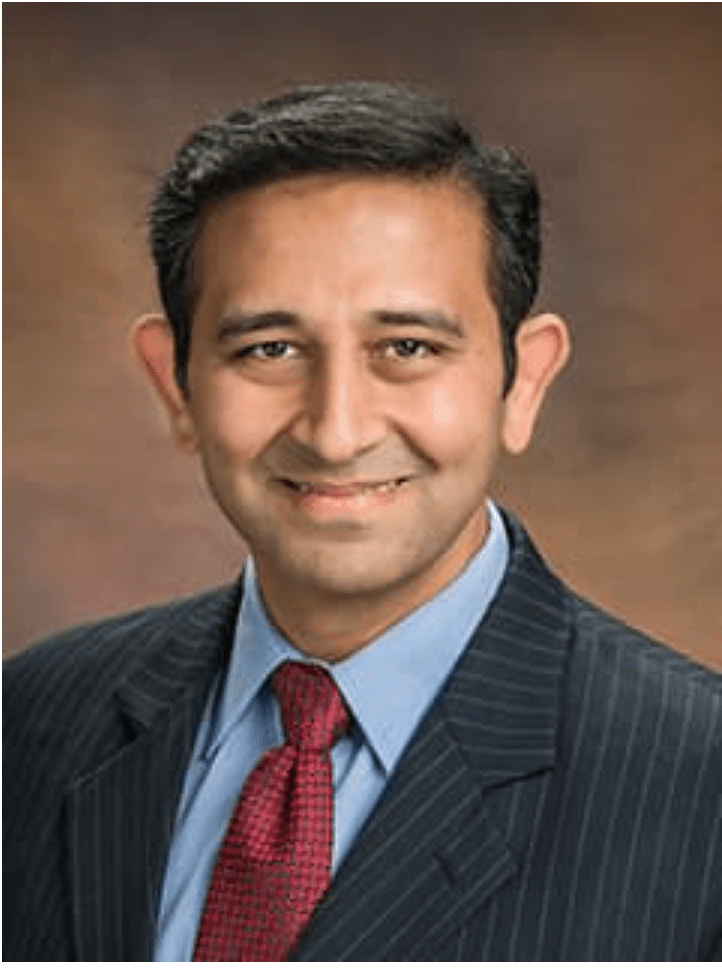
Dr. Rajeev Iyer MBBS, MD, MS, FASA (USA)
Associate Professor of Anesthesiology
University of Pennsylvania,
Philadelphia, USA
Disclaimer: The views and opinions expressed in this article are solely those of the author and do not reflect the official policy or position of the University of Pennsylvania or any other institution or entity.

